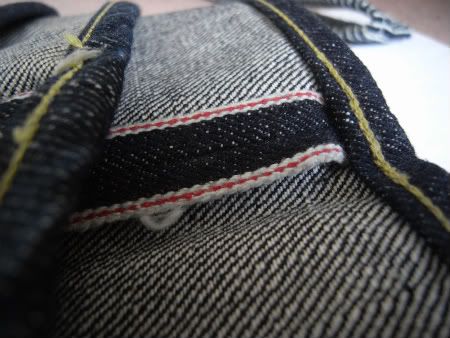Denim - The Details
-
i do love you jaco. great shots & thanks for dumbing it down for me so i can follow along
-
Very very cool Jaco, well done and thanks!
-
Well it's been in just about every other thread I can stick it in, so I'll stick it here as well:



-
The 18oz raw denim is designed to be hairy and slubby, that is why they fade with such great contrast. The hairiness will disappear with abuse….
Thank you!
As promised
L to R 25, 21, 18oz

18oz

21oz (sanforized)

25oz

-

21/23oz Raw, Wabash(old version), 17oz. Duck
-
-
It reminds me of one Glory PArk Flannel I loved. This fabric is awesome and I'd buy it in a second.
-
Indigo works by a chemical reaction called oxidation-reduction.
Indigo does not dissolve in water. It must be
reduced — i.e. the oxygen must be removed— in the
presence of alkali
by a reducing
agent such as
thiourea dioxide
(thiox), sodium
hydrosulfite, Zinc, or bacteria. Upon reduction, indigo
becomes colorless and water soluble. In this state,
indigo has a high affinity for cellulosic fibers and enters
the open spaces of the fiber. The dyed fibers are then
exposed to air, which oxidizes the dye molecule back to
its insoluble form. The insoluble dye particles are
trapped inside the fiber, coloring them permanently blue.
Unlike most dyes, indigo forms a mechanical, not
chemical, bond.Ok. So in it's reduced state (oxygen taken out, water soluble) indigo is colorless and will adhere to fibres. When air is introduced (oxidization no longer soluble) the fibres are turned blue. This is why in rope dyeing they are put in the vat, taken out, left to dry and then the steps are repeated to achieve the desired hue/darkness.
hope this helps!
heres the link i pulled that blurb from. I'm no scientist! (opens as PDF)
http://www.google.com/url?sa=t&rct=j&q=&esrc=s&source=web&cd=1&cad=rja&ved=0CDEQFjAA&url=http%3A%2F%2Fblogs.cornell.edu%2Fgarden%2Ffiles%2F2009%2F04%2Fintroduction3.pdf&ei=dWWsUO_aPMuy0AH3jIDwBg&usg=AFQjCNE1XEx_k9aie3imZ-4SAVLwDn1poQ






